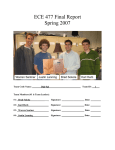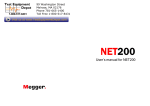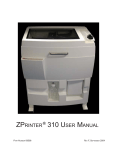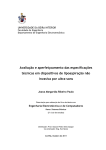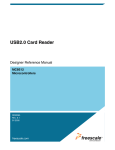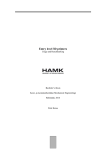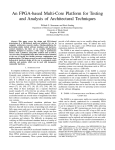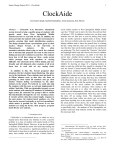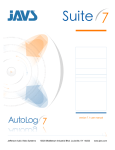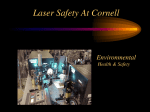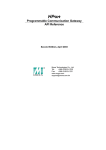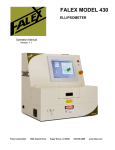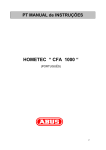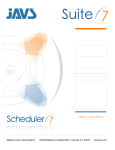Download Kimberly J. Atiyeh Pamela M. Bays Charles M. Ekstien Ashley M
Transcript
Kimberly J. Atiyeh Pamela M. Bays Charles M. Ekstien Ashley M. Regazzi Daniel S. Wong Columbia University Department of Biomedical Engineering Table of Contents 1. Design Problem 2. Design Brief 3. Basic Summary of the Problem 4. Product Description from an Engineering Design Prototyping Perspective 5. An Interview with a Caregiver 6. Safety Consideration 7. Development of Target Specifications 8. Consideration of the Needs of Hypothetical Clients 9. Preliminary and Alternative Designs 10. Final Device Design 11. Consideration of Accessibility and Universal Design Principles 12. Accumulation of Costs 13. Cost of Final Prototype 14. Detailed Analysis of Prototype 15. Images of Final Prototype 1. Design Problem Millions of Americans currently depend on a daily medication regimen, often consisting of multiple drugs in different dosages and schedules. Current management solutions rely solely upon the individual to remember to take certain pills on certain days at certain times. These systems are inefficient and can result in serious medical complications from inaccurate and missed dosing. In addition, no single product currently available combines enough functionality to completely streamline the process. 2. Design Brief Our goal was to develop a low-cost, portable device that unifies the various elements of a dosing schedule, pill manipulation, and physician correspondence into a single accessible device. The prototype includes the prescribed specifications of dispensing correct dosage (1, 2, or ½ pills) of a single medication only on a preset schedule, alerting the user when a dose should be taken, relaying a message offsite in the case of a missed dose, and multi-modal indicators of current status. In addition to these basic design elements, we also included a method of alerting both the user and a pharmacy when refills are needed, as well as the ability to accommodate for pills in a variety of shapes and sizes through interchangeable cartridges. The device is powered by a rechargeable battery that connects to a base station charger kept in the user’s home. All of the device controls are clearly accessible by following the prompts on an LCD interface screen. The base station not only charges the portable dispensing device, but also connects to the dispenser via Bluetooth and can send information through an Ethernet connection to a caregiver or doctor to transmit missed dosages and other adherence records. Furthermore, our design includes a novel and efficient approach to cutting pills and multiple alert modes (including audible notifications with volume controls, a vibrating feature, and a notification light). Our primary design focus was to deliver a device that is easy to program and use, which includes clear settings and a simple user interface, to maximize usage benefits and can be enjoyed by users of all ages and levels of physical fitness and dexterity. 3. Basic Summary of the Problem 3.1 Inconsistent Medication Routine Prevalence Research has shown that many people dependent on medication regimens do not take their medications as prescribed by a doctor. It has been found by various studies that 50% of patients over 60 years old do not take their medications as directed1. In one example, “a study of 130 patients discharged from four hospital wards dealing mainly with acute medical cases showed that 66 deviated from the drug regimen prescribed on discharge. Of the patients, 46 did not have a clear understanding of the regimen (noncomprehension) and 20 of the remaining 84 patients understood the prescribed regimen but did not follow the instructions (non-compliance).”2 Over half of the patients in this study did not take their medications as prescribed. Non-compliance (65%) could be due 1 UK Department of Health, http://www.dh.gov.uk/en/Publicationsandstatistics/Publications/PublicationsPolicyAndGuidance/DH_400 8020 2 A study by D M Parkin, C R Henney, J Quirk, and J Crooks, http://www.pubmedcentral.nih.gov/articlerender.fcgi?artid=1688349 to participants simply forgetting to take their medications, not wanting to worry about following a strict schedule, or simply choosing not to worry about attempting to do so. It has also been found that approximately 36% of people aged 75 and over take four or more prescribed drugs1, which may be impossible to manage without some form of help. Alarm clocks, positioning medication in visible places, and taking medication at routine times (such as meals) have all been found by older people to be helpful in reminding them to take their medications3. 3.2 Health Problems Due to Non-Compliance Not taking medication as prescribed can lead to major health complications. 35% of patients make potentially serious errors in not following their medication regimen, which result in 11% of all hospital visits each year. This may include overdosing or missing a dose of necessary medication. An estimated 125,000 lives and $100 billion could be saved each year with better medication compliance.4 Medications which are necessary for survival are often not taken regularly. People who have had a myocardial infarction are 2.5X more likely to die within one year if their medications are not taken as prescribed. Of those who have had an organ transplant and did not take their medications as prescribed, 91% have died within one year. 5 3.3 Causes of Non-compliance According to the Office of the Inspector General6, there are four main causes of medication non-compliance: z “Physiological factors: Loss of vision or hearing can impede an elderly person's ability to read important information about his prescription or to hear instructions about his regimen. Mobility limits, type of disease, the presence of symptoms, memory loss, depression, and cognitive impairment are other physiological variables that can negatively affect compliance.” z “Behavioral factors: These include social isolation, social and health beliefs, and economic condition. Many elderly people live alone. Studies have shown that people who live alone more often fail to comply with medication regimens. For those elderly on fixed, minimal incomes, the ability to purchase expensive medications may also be a factor in noncompliance.” z “Treatment factors: These include the duration and complexity of the medication regimen. Compliance rates decrease when the treatment is long-term and when the regimen includes many different medications that must be taken concurrently. Other treatment factors include the type of medication prescribed, and the patient's perception of the medication. “ z “Health Care Provider/Patient Interaction factors: These include how well the physician, the pharmacist, and the patient communicate with each other. The 3 Social Care Institute for Excellence, http://www.scie.org.uk/publications/briefings/briefing15/index.asp 4 Information Technology Association of America, http://www.itaa.org/isec/events/presentations/1154.ppt#375,12,Where Is The Problem The Biggest? 5 School of Pharmacology, London http://www.patientsikkerhed.dk/admin/media/pdf/dff1ef42849b6990b0673e8f0ed1561a.pdf 6 Office of the Inspector General Report, http://oig.hhs.gov/oei/reports/oei‐04‐89‐89121.pdf quality and content of a physician's instructions, the content of a pharmacist's label, and the ability of a patient to ask questions can all affect compliance.” 4. Product Description from an Engineering Design Prototyping Perspective 4.1 Who is the customer: The customer would be the drug store or pharmacy to stock the device and sell it. This method of distribution will allow for wide market availability and reduce the need for an independent distribution network. 4.2 Who is the user: The user would be a person with a strict medication schedule, and/or a person who needs several different types of medication per day (who would purchase multiple devices). 4.3 What type of device is needed: A device is needed that can reliably dispense medications when a user needs them and can be programmed by a doctor of pharmacist if necessary (i.e., if a user does not understand his/her medication schedule). Many of the reasons cited about why noncompliance exists are due to the fact that several different types of medications are needed several times a day. This sort of schedule is difficult to manage, especially if cognitive ability is impaired. In addition, the device must be able to accommodate many types of pills. 4.4 Why our approach is crucial to health care needs: Many different medication management devices are available on the market. Many products that have functions similar to our device cost hundreds of dollars, and therefore are not affordable to a majority of medication-dependent people. There are several devices lower in cost available, but these do not have the same functionality as the intended functionality of our product, i.e., dispenses pills only when timer goes off, both vibrates and beeps, calls a family member/friend/doctor if a dose is missed, etc. In addition, none of the devices researched were able to cut pills. 5. An Interview with a Caregiver 5.1 Interview with Ann Erikson, caregiver for mostly elderly clients. Communicated via email, 10/11/2007 How important are aesthetics? Many people keep their medications in one place, and generally that place is not on display. That is, medications are generally kept in dedicated cabinets, drawers, or areas on a counter. While I think that aesthetics are always important to an extent, many elderly people have been taking pills for years and have gotten used to keeping their medications out of sight. How important is size and portability? For most people, not that important. Most of my clients live in nursing homes, assisted living developments, or retirement communities. They generally stay within their homes or buildings, where meals are provided, entertainment is available, and other people come to. I would say that most clients of mine leave their homes or communities anywhere from 1 to 4 times a week, usually to do grocery shopping or get a meal with family or friends. These ‘excursions’ generally don’t last too long – a few hours at most. Because my clients tend to leave with such a low frequency, portability may not be that important to them. Where are your clients generally when they take their medications? A variety of places. You’d be surprised where some people put their medications. The most common places are in the kitchen, in the bathroom, and by a bed. What do your clients use now to organize their medications? Almost all of my clients use pill boxes. Many use the standard SMTWRFS boxes but those that take medications multiple times a day, quite a lot, use pill boxes that have separate compartments for morning, noon, evening, night. Do many clients require the use of a pill cutter? How do they currently split pills? Splitting pills is a difficult task for many people. A lot of my clients have problems with arthritis and opening pill boxes or bottles alone is difficult. Some people have pill cutters that they use, but even so, many cutters require the user to position the pill in the cutter first, which can be a painful task for a lot of people. Those that don’t have pill cutters use knives, but even I have difficulty using knives to cut pills. I can’t imagine it’s easy for them. Do your clients ever miss doses? If so, why? I think they miss doses more than they realize. I actually call my own parents who are in an assisted living community to ask if they’ve taken their medicines and while they say yes most of the time, I often find when I go over there that the number of pills I count in the bottle is the same as it was the day before. For my own parents, I would attribute this probably to dementia. It’s easy to forget when to take a medication, but I think also that people falsely remember taking pills. By that I mean for example they think they remember taking a pill earlier in the afternoon, but in reality it was the previous afternoon. For other clients who miss doses, it probably has a lot to do with the difficulty of taking pills. What are your clients’ common complaints about medications? Dosages change regularly, pills are difficult to handle, pills are difficult to swallow, they can’t remember if they’ve taken the pill yet, they taste bad, it’s painful to open the bottle, they have to schedule their day around taking pills, they hate having to cut the pills, they hate having to go get refills. 6. Safety Consideration 6.1 Safety Concerns The foreseeable major safety considerations are as follows: 1. Environmental Factors: The pills must be contained securely so that undesired moisture or other environmental contaminants are unable to get inside the bottle. The pills might be sensitive to overexposure of different elements, and keeping dirt and other small detritus out is a hygienic concern. 2. Water and Electrical Hazard: While the voltage from the battery in the device will be too low to cause serious harm to the user, it must be protected from water and from accidental feedback that could damage the battery and cause its contents to leak. The base station has a higher risk of electrical shock associated with the higher voltage and should be designed to carry no risk of serious shock or injury to the user. The base and cap should be designed to include minimal electrical contact points that are as small as possible. 3. Mechanical Hazards: Since the device will have a very sharp razor blade as part of the pill cutting apparatus, the blade must be firmly seated without the ability to be removed (consciously or accidentally) by the user. The blade must be readily visible to reassure the patient that the integrity of the metal is consistent. If the blade is not secured in a strong housing, there is a possibility that it could become harmful to the user. Either the housing could crack, exposing the blade, or the blade could fracture, and pieces of either could be dispensed along with the medication. 4. Medical Safety and User Interface: This is by far the largest category of danger for the user and could be potentially harmful or fatal to the user. Sections of the FDA Medical Device Use Safety Risk Management are related below: Summary Since our device is a modification on an existing product (a pill organizer/dispenser) and there is no high rate of morbidity/mortality from misuse, we are exempt from FDA premarket notification. Unfortunately there is no specific reference in the Device Classification Panels, though our product would probably fall under Part 880, Subpart G (General Hospital and Personal Use Miscellaneous Devices).7 7. Development of Target Specifications 7.1 How is it powered? Since the device needs to be portable, the dispenser/cutter will be powered by a rechargeable battery. The device will come with a charger base upon which the dispenser/cutter will remain seated until a pill is needed, or the dispenser/cutter needs to be brought to another location away from home by the user (i.e., if the person would like to go out for the day). The base station itself will be powered using a standard 120V AC wall socket connection with a DC transformer. 7 http://www.accessdata.fda.gov/scripts/cdrh/cfdocs/cfcfr/CFRSearch.cfm?CFRPart=880 7.2 How can it be tested? A prototype can be easily tested by adding pills to see if the device dispenses and cuts pills at the appropriate times. Since the device is a Class I FDA device, it does not require clinical trials before commercial use. 7.3 Do ergonomics matter? Yes. The device needs to be portable, needs to have an LCD screen with a large display font, and will have large buttons for ease of operation by users with limited or otherwise impaired dexterity. 7.4 Does style matter? Yes. It will need to be presentable as a reliable medical device. 7.5 Does accessibility matter? Accessibility is a major portion of this project. The intended user is a person who needs to take medications several times per day. Since elderly people and people with disabilities could have poor dexterity and may not want to spend time learning how to use a complicated device, the device needs to be very accessible. 7.6 Is training required? No. The device will be straightforward to use by simply reading the user manual. Additionally, any added complexity of the device that would necessitate training would introduce additional avenues toward misuse and potential failure of the device, both physically and as a product intended to reduce complexity and errors associated with current medication management methods. 7.7 What is the product’s social impact? The primary impact of this product will be the improvement of quality of life for people who must maintain a strict dosage schedule. There would be fewer medical issues due to medication not being taken as prescribed. In addition, the device's users could become more independent and not have to rely on a friend or family member to aid in their medication routines. Greater independence will be the single most noticeable effect of this device on its users. 7.8 How is it sold? It will be sold to drug stores and pharmacies so users can buy the device over-thecounter at their own discretion or if recommended by a healthcare provider. Labeling on the device packaging would encourage customers to bring the device with them to the doctor’s office for programming and additional support, if necessary. 7.9 How much will it cost to buy? The device should cost no more than a few hundred dollars for users. Since many people are on multiple medications, the device must be affordable enough to allow users to purchase multiple units. 7.10 How important is reliability? Reliability is crucial. Users will rely on the device in order to correctly take their medications. Failure of the device could result in serious issues due to overdoses, missed doses, and inconsistent dosing. A secondary reserve battery could be used to provide minimal power to the device's clock in the event that the primary battery becomes depleted. 7.11 How will it be serviced? The product will come with a warranty in the event of a defective device. However, the product is not meant to be serviced. Once the device wears out, we intend that the user will simply purchase a new one. The pill-cutting module of the device should be available separately so that it can be replaced when it wears out, reducing the user’s cost of maintaining the device. The device’s pill-cutting attachment will need to be replaced approximately every three refills to ensure proper function. 7.12 What is the life of the product for the user? The device should not malfunction or wear out for at least two years. Most likely, the battery life will slowly be depleted, and it will stop responding to recharging. Two years is an acceptable length of time for the cost of the device. The cutting blade should last through one prescription at the very minimum, so for a three-month prescription calling for ½-pill doses twice per day involves one cutting operation per day for 90 days; the blade apparatus should be useful for at least that many uses. 7.13 What are major safety concerns? There are small parts to the device, and thus it should not be left in an area accessible by young children. However, the largest concern is for malfunction and causing the user to be unable take their medications exactly as directed by a doctor. 7.14 Is it affected by FDA or other regulations? This device would be considered a Class I device and would not require FDA approval. The device would need to function as described on the packaging and would not be intended to override any sort of pharmacist’s or doctor’s directions. 7.15 Who is the user? The user would be a person with a strict medication schedule and/or a person who needs several different types of medication per day (who would purchase multiple devices). 7.16 How is the device better than others? This device would be able to cut pills, a feature not included in most pill dispensers marketed currently. Also, the device would alert a friend, family member, or pharmacist is a dose is missed. 7.17 How does it work? The device consists of two parts: a portable dispenser and a base station to be kept in the user’s home. The base station will be powered by electricity and will communicate using either a Bluetooth radio or an Ethernet connection, while the dispenser will contain a rechargeable battery. The dispenser contains the device controls and display, the cutting attachment, and the relevant machinery for each component to function. 8. Consideration of the Needs of Hypothetical Clients "Phylis is an active 77-year-old woman with rheumatoid arthritis that has caused diminished hand strength, joint stiffness, and pain. Phylis also has age-related macular degeneration and hearing loss, but she is determined to remain active and independent. Although she is outgoing and bold in general, she is easily intimidated by many of the hightech gadgets her grandchildren use; she prefers simple interfaces." If Phylis takes pills for her RA or for other health issues, she would greatly benefit from the freedom of having a device to notify her when it is time for the medication, dispense the pills, and cut the pills if needed -- abilities that the iQueue can handle well. Due to her diminished hand function and dexterity, the cutting and dispensing of medication would be especially useful. "High-tech gadgets" are often intimidating to people who are not used to them, and therefore the instructions will be made extremely clear and the user-interface will not be complicated to use. The device is very portable -- about the size of a book -- allowing Phylis to maintain her active lifestyle. "Aaron is a 23-year-old man, a returning Iraq war veteran, with an arm amputation above the elbow, chronic neck pain and recurring headaches. Although Aaron sometimes wears a prosthetic device with a pinching mechanism, most often he improvises and uses one hand to complete tasks. He takes a number of medications, mostly for pain management." It may be helpful for Aaron to have a pill dispensing device like the iQueue to remind him when to take all of his medications. In addition, if any of his medications require cutting, it may be a challenge for him to complete this task. A pill dispenser with cutting capabilities would allow him the ease and freedom of cutting pills with the use of only one hand. The device's great portability will allow Aaron to travel and keep active. "Keisha is an 84-year-old woman who recently had a stroke, causing hemiplegia on her right side that has affected the function in her dominant hand. She has also experienced some memory loss after the stroke, so she appreciates the reminders her family provides her. Before the stroke, Keisha had minor hearing loss, and it has continued to worsen in recent years due to aging. Although she wears a hearing aid every once in a while if she’s going out, at home and at most other times she does not use it. She also has occasional challenges with incontinence." If Keisha takes pills for her health issues, she would greatly benefit from the freedom of having a device to notify her when it is time for her medication, dispense the pills, and cut the pills if needed. Due to her diminished dominant hand function and dexterity, the iQueue's cutting and dispensing of medication would be especially useful. Since Keisha has some hearing loss, a device with both an auditory and visual/vibrational notification system would be the most helpful to her. The caregiver/physician notification system will allow Keisha to get additional help if she still cannot maintain a correct dosing regimen. "Jerry is an 82-year-old man with Parkinson’s disease, which causes him to have tremor, rigidity, and decreased range of motion; he also has difficulty with urinary control. Jerry has recently started experiencing symptoms of Dementia, but with the help of his family he is determined to remain in his own home as long as possible." If Jerry takes pills for his health issues, he would greatly benefit from the freedom of having a device to notify him when it is time for his medication, dispense the pills, and cut the pills if needed. Due to his decreased motor function, the iQueue's cutting and dispensing of medication would be especially useful. The portable iQueue device would allow Jerry to control his dosing regimen independently and safely. The caregiver/physician notification system will allow Jerry to get additional help if he still cannot independently maintain a correct and healthy dosing regimen, and his family would be free to continue to give him certain reminders. "Jamie is a 42-year-old woman with a T11 spinal cord injury. She mainly uses a manual wheelchair and is a serious wheelchair basketball athlete. She would like to have better control of her urinary function while participating in athletic activities." If Jamie takes pills for any health issues, she could greatly benefit from the freedom of having a portable device to notify her when it is time for her medication, dispense the pills, and cut the pills if needed, which would help her to continue to maintain her very active lifestyle. The device is very easy to carry around, allowing Jamie to maintain her independence. "Betty is a 65-year-old woman who has limited and asymmetrical lower extremity range of motion due to a bad hip. She also has limited strength in her right leg due to decreased use of her right leg because of the pain caused by her hip." If Betty takes pills for her health issues, she would greatly benefit from the freedom of having a device to notify her when it is time for her medication, dispense the pills, and cut the pills if needed. The iQueue is very portable, allowing Betty to maintain her active and independent lifestyle "Violet is a 32-year-old woman of short stature who is on blood pressure medication. She is also a mother of 3, and is very active within her family and community." If Violet takes pills for her health issues, she would greatly benefit from the freedom of having a portable iQueue device to notify her when it is time for her medication, dispense the pills, and cut the pills if needed. Being a mother of three, she would find the auditory, visual, and vibrational reminders useful in organizing her medication regimen. "Paul is a 43-year-old man with diabetes. The diabetes has caused neuropathy in his hands and feet, which eventually necessitated two below-the-knee amputations, and some loss of vision." If Paul takes pills for his health issues, he would greatly benefit from the freedom of having a device to notify her when it is time for her medication, dispense the pills, and cut the pills if needed. The auditory reminders and clear user interface would be most useful to him due to his slight loss of vision. 9. Preliminary and Alternative Designs As we began the design process and started developing concrete design parameters, we focused on three initial designs. Each addresses many different aspects of the competition specifications, from given constraints to what we saw as necessary for the livelihoods of our product's users. Of the designs below, none of them are evident in our final prototype as a whole; we were able to take the best aspects of each and combine them into our final device, creating what we believe is the best solution to the given problem. For our first idea, we were not sure how to encase all of the prescribed functions into a pill cap. This machine, appropriately dubbed “the espresso machine,” would sit on a countertop, be incredibly easy to load with one or multiple pill types, and would be able to pull power from the wall outlet to perform functions. With this much space, we would not have had a problem holding all the components, but its bulk was about as far from a “cap” as possible. The cutting mechanism works by taking a pill from the well, securing it tightly in a small area, and then rotating around, meshing with a separate wheel with a blade to cut the pill. The espresso machine was a great start, but we had a long way to go, especially in the size part of the design. We wanted to make sure that our customers could carry their medication dispenser with them discreetly, and not have to always worry about being home at the right time to take their medications. We used this notion as a springboard to develop our next design, making some concessions and trying to fix the problems that we had foreseen. In this idea (“the cassette player”), we shrunk the entire device – it is still not a pill cap, but it is starting to approximate something portable. The user would load a small, disposable cassette with pills of a specific type. This cassette will have apertures for multiple days' worth of an average medication regimen for that particular pill and will fit securely in the device. The dispenser itself will have a very easy interface to navigate with a large LCD screen to display all the relevant information to the user. Also, as in the first idea, the user will not be using any force to cut the pill – this will all be done mechanically so that anyone with a loss of dexterity or strength in their hands will be able to easily operate the device. Cutting on this device is also a little bit different from before. Here, the device does not so much “cut” as utilize a three-point bending system to break the pill in half. A major concern of these devices is knowing when a pill should be cut. Most pills are not designed to be cut, and all pharmacists recommend never cutting pills unless specifically directed by a physician. This second idea would include programming that would only cut a pill if specifically directed to do so. However, we were still not satisfied with our design and we felt that, among other things, loading the device should be much easier and the size should be even smaller. Our last preliminary idea finally resembles a pill cap, though it is significantly larger than any regular cap on a bottle of the same size. This last idea really tried to combine the best aspects of previous designs into a sleeker package. From the simple interface with LCD screen right on the device to the easy attachment of a whole pill bottle to eliminate the need for constant refills, this idea seemed to be a great aspiration. It was discreet, portable, and included a lot of features (like a vibrating alarm) that would be a comfort to the user. The separate base station would act as both charger and data hub, charging the device about once a week and uploading relevant medication information to a pharmacist or physician. Cutting was accomplished using a rotational motion similar to those used in common pepper grinders. All of these ideas addressed specific constraints and helped us to develop our final prototype design. Problems that we foresaw with each idea were considered, and eventually we were able to use them to incorporate just about everything we wanted into one accessible device. 10. Final Device Design A user can adjust the iQueue to his/her own medication regimen by setting the device to "program" mode, following the simple set of questions displayed on the LCD screen, and responding with button-pushes. The user interface is similar to that of an automatic teller machine, with predefined menu options. All programmed dosing schedule information, as well as a record of whether or not a dose was successfully dispensed at the appropriate time, is recorded to a removable media card. Four (4) AAsize batteries or two (2) rechargeable lithium polymer batteries provide power for the iQueue. Once the iQueue is programmed, the mode must be set to "load" so a pill cartridge of up to 14 pills can be loaded into the central column. The iQueue is then ready for use when returned to "lock" mode. At the times of the day designated by the user, the cutting and/or dispensing motor is engaged. The pill at the top of the column is displaced from its resting position to the cutting position, where the blade advances to cut it in half. Half of the pill is dispensed via the release hole and the other half is retained in the iQueue by the advanced blade. The patient is alerted by a set of audible beeps, which, if the user prefers, can be switched instead to a strong vibrating alert or a bright red light, so the dose can be taken as prescribed. Processor. An Atmel ATMega168 microcontroller programmed in an Arduino physical computing environment provides control for the various components and features of the device, including motor control, the user interface, and data recording. LCD screen. Displays messages in high-contrast with white text on a black background. Buttons. Four tactile-response buttons that the user can push in response to prompts from the LCD. Setting switch. There are three modes: 1) The "program" setting prompts a set of questions that enables the user to set the time, date, timing of dose, and quantity of dose; 2) The "load" setting allows for user to open the iQueue and insert the pill cartridge; and 3) The "lock" setting prevents opening of device for safety reasons. microSD card and socket. Dosing schedule and dosing history are stored to commercially-available solid-state removable media card for later analysis and/or transmission to a healthcare provider. Pill cartridge. An internal casing that can be customized and replaced for different pill types and can hold at least fourteen pills, depending on pill dimensions, that have been stacked and oriented. Platform. A spring-loaded platform that advances pills to the top of the cartridge. Motor. 141:1 gear ratio 5-Volt motor that advances the cutting blade along the blade track. Angled blade. A long-lasting steel blade that cuts pills cleanly with minimal force. Cutting block. Pills are pushed here prior to cutting. When the blade is advanced, the pill is cut using a combination of force and three-point bending. The dispensed pill exits here. Infrared sensors. The positions of pills within the column and cutting block are tracked, allowing the processor to intelligently operate based on the status of the device. Pushing mechanism. The user must simply slide a lever to dispense a pill. Multimodal indicators. LEDs, a speaker, and a vibrating motor -- in any combination -alert the user when a dose is ready. Power supply. The device is designed to draw power from and last for at least a week on two rechargeable lithium polymer batteries. 11. Consideration of Accessibility and Universal Design Principles The Principles of Universal Design have been developed through the Center for Universal Design by a working group in 1997 (Story, 1998; Story and Mueller, 2002), and include the below considerations for universal accessibility. 1. Equitable Use: The design is useful and marketable to people with diverse abilities The user interface and instructions can be easily navigated by people with a wide variety of electronic and mechanical skills. The ability to use the device is the same for most users, regardless of background and other variations, including but not limited to older users and users with disabilities or other health issues. The three different types of notification systems – auditory (beeping), visual (flashing light), and vibrational – will allow people with impaired vision or hearing to use the iQueue device equally well. Some users may have trouble loading pills into the device if they only have limited dexterity in their hands, and may ask for help during the initial loading of the device. 2. Flexibility in Use: The design accommodates a wide range of individual preferences and abilities The program allows for users to schedule dosing by day (i.e., 3 times a day) and by hour (i.e., every 8 hours), depending on their preferences for how they understand their dosing schedule best. In addition, the user can choose any or all of the notification alarm systems, turning one or more off depending on situation and setting. The pace and handedness of use are not factors that would decrease ability for a person to use this device. 3. Simple and Intuitive Use: The design is easy to understand, regardless of the user's experience, knowledge, language skills, or current concentration level After the initial programming, the device requires minimal involvement in maintaining an effective medication regimen. If the user has some ability, the device is easy to use and to program. If the user is unable to program or load the device, and if a friend, relative, or physician is available, they can provide initial help in setting the dosing schedule, after which the user can use the device independently. The high-contrast display shows instructions clearly, and a person could easily follow the prompts and program the device without training. A person who only has very limited English reading skills may have some trouble in programming the device and may have to ask someone to translate the prompts for initial programming. 4. Perceptible Information: The design communicates necessary information effectively to the user, regardless of ambient conditions or the user's sensory abilities. Due to the high-contrast display and multiple notification systems, people with diminished hearing and visual abilities can still enjoy full use of the device. However, if the user has total vision loss, then this person may require some assistance in initially programming the device due to the fact that the prompts for programming appear on the screen. After the initial programming, though, this person could simply be instructed as to which button to push to dispense the pill after the alarm sounds. He or she can then simply push that button each time the alarm is heard or felt (due to the vibrator motor notifier). 5. Tolerance for Error: The design minimizes hazards and the adverse consequences of accidental or unintended actions. The most hazardous element, the sharp cutting blade, is well-shielded and there would be no way that the user would come into contact with it unless the device was deliberately disassembled. The most probable malfunction of the device would be the loss of power due to battery-life loss, causing it to fail to notify the user when to take his or her medication. However, this would be preceded by the screen becoming dim and the notification system elements becoming less noticeable, thus indicating that the battery must be charged. If the user simply gets into the habit of leaving the batteries charging while at home, then the batteries should never run out of life at a crucial time. In addition, the iQueue Pill Dispenser has a override ability, in the case that a pill is dropped by the user (i.e. on a dirty floor) and another is immediately needed. 6. Low Physical Effort: The design can be used efficiently and comfortably and with a minimum of fatigue The device is designed so that pills are dispensed with the slide of a lever and the push of a button, thus minimizing fatigue and physical effort in any body position of the user. Manipulation and repetitive actions on the device are only needed during initial programming and loading. 7. Size and Space for Approach and Use: Appropriate size and space is provided for approach, reach, manipulation, and use regardless of user's body size, posture, or mobility. The device is small enough for a user to pick up and take with them, even place in a bag, regardless of the person's strength or motive ability. A person of any size and strength or with limited space can easily use this device. 12. Accumulation of Costs Costs as of February 21st, 2008 Costs as of March 26th, 2008 Costs as of May 5th, 2008 Sum Total of Monies Used as Part of Design Competition Fund: $1,193.29 Additional Monies Used in Development of Prototype: ______________________________________________________________________ Complete Total Used in Development of Device Prototype: $1,405.01 13. Cost of Final Prototype The total cost of all of the components in the final prototypes is $639.41. This cost is extremely high, but this can be attributed to the fact that many components would be far less expensive if ordered in bulk, mass-machined, or priced via negotiation. It is estimated (by viewing the various company's bulk ordering prices, and by looking at alternative dealerships) than many of these component's prices could be reduced by at least 50%, thus making the device cost about $300 to manufacture. 14. Detailed Analysis of Prototype The final iQueue prototype consists of two primary sections: the dispenser, and the base station. These parts complement one another and provide the necessary functionality for a full-feature managed pill dispensing system. The dispenser section provides most of these functions, including medication storage, timekeeping, scheduled alerting, pill dispensing, pill cutting, and medication dosing monitoring. The base station supports the dispenser by extending its functionality beyond what the portable dispenser section could reasonably accommodate and remain portable, namely the recharging of the dispenser’s batteries and communication to a healthcare provider. The base station and dispenser share a common microcontroller foundation for their electronic components; the dispenser itself also has a mechanical component associated with it, necessary for the physical manipulation of medication. A microcontroller was used as the basis for the iQueue dispensing system in order to provide the greatest functionality and flexibility for the specified design objectives. The Arduino electronics prototyping platform was selected for this purpose, as its open-source nature reduced development costs while still providing both breadth and depth of interactive functionality, and in addition, the Arduino platform is based on a C/C++-like language, making it easy to program. Using this platform as a foundation, the user interface and overall functionality of the iQueue system could be fully customized and prototyped in a fast an efficient manner. By interfacing with various hardware components, the microcontroller provided the means by which the iQueue could meet all of the design objectives. Similarly, the use of a ZPrinter 310 Plus 3D-printer further allowed for the rapid development of the iQueue dispenser’s mechanical parts, which were designed in the SolidWorks 3D CAD program. Electronic Components User Interface A central component of the iQueue, both in the dispenser and the base station sections, is the user interface, which is composed of a liquid crystal display (LCD) and four tactile buttons. The display, a two-line, 16-character, white-on-black LCD, was chosen for its ease of integration with the Arduino platform, as well as its size and highcontrast display. The tactile buttons were selected over other options due to considerations regarding ease of use for users of the iQueue, and specifically because the tactile buttons provided a physical feedback response to the user. In addition, larger buttons could be made an placed over these smaller tactile buttons, allowing for flexibility in the final product design to accommodate the needs of a wide range of users. This user interface was designed and programmed to be simple and straightforward, with a menu system similar to that of automatic teller machines (ATMs) commonly found in banks, grocery stores, and other commercial operations. The benefit of this design is that no special instruction or training is necessary to operate the iQueue. The LCD used, a Xiamen Ocular GDM1602K display, uses the common HD44780 parallel interface chipset. The Arduino board can be programmed to interface and control this LCD using a four-bit LCD display driver library developed by a member of the Arduino development community. The addition of this device in the electronics of the iQueue occupied six of the Arduino’s 13 digital I/O pins, and increased electrical consumption of the circuit by a maximum of 170mA. In order to conserve the use of the Arduino board’s digital I/O pins, one side of each of the buttons was wired to a resistor, each with a different value, and the other side connected to group through an LED, as well as one of the analog inputs of the Arduino board. In this manner, each of the buttons, when pressed, would close the circuit with a specific voltage determined by the resistor, and this voltage would allow the microcontroller to differentiate between the different buttons. Data storage & Communication Another primary component of the iQueue is its data storage and communication abilities, the latter of which has been broken out into two separate parts: internal communication between the base station and the dispenser, and communication between the base station and a healthcare provider. The data storage unit also stores the medication dosing schedule that the user can program into the iQueue. Given the portable nature of the iQueue’s dispenser portion, it is not always possible for the device to be able to contact a healthcare provider on a regular basis, as a connection by phone or internet may not always be available. For this reason, a data storage device was incorporated into the iQueue dispenser, allowing medication dispensing information to be recorded and stored until a time when a connection could be made to contact a healthcare provider. The device used to achieve this functionality was a microSD card socket based upon a DOSonCHIP module, which provided a basic DOS interface and file system compatible with those currently used by popular operating systems in modern personal computers. The use of this common file system allows the data stored by the iQueue to be read without any special software to convert the files. The particular microSD card socket module used also includes a built-in real-time clock, which allows for the time and date of each scheduled doss to be recorded on the card. The microcontroller can interface with this module using a serial universal asynchronous receiver/transmitter (UART) interface over two pins of the Arduino board, and increases the power consumption of the iQueue by 5mA. Communication between the dispenser and the base station is used to relay data through the base station to a healthcare provider; to do this, a pair of Bluetooth radios are used, one in the dispenser, and one in the base station. The Bluetooth radios used are the BlueSMiRF modules by Sparkfun Electronics, based upon the Roving Networks RN-41 Bluetooth module. The microcontroller can interface with this module using a serial universal asynchronous receiver/transmitter (UART) interface over two pins of the Arduino board, and increases the power consumption of the iQueue by 160mA when active. Since both the Bluetooth radio and the microSD card socket must both use serial communication with the microcontroller, and the Arduino board has only one hardware serial port, the microSD card socket was moved to a software serial interface, still only using two digital I/O pins on the Arduino board. Communication between the iQueue base station and a healthcare provider can be achieved through the use of an embedded server module, the Lantronix XPort AR. This device provides support for an Ethernet connection to a network and the internet, and supports a wide range of internet protocols, including TCP/IP, HTTP, FTP, SSH, and SSL, as well as the SMTP mail transfer protocol. Using this, the iQueue can transmit data to healthcare providers in multiple formats, either by e-mail or secure connection to a website or server. Motor Control The iQueue dispenser can also cut pills in order to dispense a ½ pill dose. Current pill cutting devices require the application of significant physical force from the user in order to do so; the iQueue uses a small direct-current (DC) motor to do this instead. Loading experiments on text pills showed that between 15 and 25 N of force was required to snap a pill in half via a three-point bending technique. Given the size constraints of the iQueue, the motor had to be small and powerful; a15mm Faulhaber motor with an encoder and 90-degree gear were chosen for this purpose. The encoder allowed the Arduino to interface with the motor with just two pins, one driving the motor forward, and the other in reverse. However, the power requirements of the motor exceeded that which could be provided by the Arduino board. Therefore, an H-bridge consisting of several transistors was used to control the motor using outputs from the Arduino board, and drive the motor directly from the iQueue’s batteries at a higher current and voltage. This required the use of four additional digital I/O pins from the Arduino board, which weren’t available. To work around this problem, an eight-bit shift register was used to convert serial signals sent by the Arduino board over three digital pins into parallel signals sent over the eight output pins of the shift register, allowing the microcontroller to control not only the motor through the H-bridge, but also left pins available for interfacing with other devices. Alert System The iQueue also features a multimodal alert system consisting of a buzzer, vibrating motor, and LED, which are all driven by the microcontroller through the shift register. Each individual alert can be toggled on or off using a simple sliding switch. Dispensing Dispensing of medication by the iQueue is monitored by infrared emitter/detector pairs located in a few locations in the device. One pair is located at the top of the dispensing column, and checks if a pill is present in the column to be dispensed. Two more pairs in the cutting block check if a pill is present in the cutting block, either being dispensed, waiting to be cut, or already cut and waiting for the next scheduled half-dose. Mechanical Components Most of the mechanical components of the iQueue were designed in SolidWorks and printed in a ZPrinter 310 Plus 3D-printer. The primary mechanical parts are: the dispenser base, the central dispensing column, the cutting block, and the motor mounting. Peripheral parts are: the dispensing knob, the column platform, column lid, spring base, and cutting block gate. The dispenser base is the core of the iQueue’s mechanics, and acts as the enclosure for the central column, the mounting base for the motor and electronic circuitry, the carrier for the iQueue’s batteries, as well as the housing for the dispensing plunger which advances pills into the cutting block from the dispensing column. The dispensing knob is connected to a 0.20” diameter spring, with a small block on the end in order to advance pills. A spring was used in order to bend through the 90-degree angle at the top of the dispensing block. The central dispensing column is the component of the iQueue which actually holds the medication to be dispensed, and was designed to accommodate pills of various sizes and shapes. The current column was designed to dispense generic acetaminophen capsules, but the interior dimensions of the column can be modified to hold and dispense other sized and shaped pills. Pills in the column are pushed upward by a spring attached to the spring base, so that the next dose is always ready to be dispensed. The column platform supports the pills above the spring, and the column lid prevents pills from being ejected from the column by the spring. The central column also has two pairs of holes near the top for infrared sensors to be mounted to detect the presence of pills in the column. The cutting block holds pills after dispensing if the pill needs to be cut, and has an opening for the cutting blade to enter the block on the bottom. The block is also grooved to accept a gate to lock pills in place while cutting. The motor mounting block holds the cutting block as well as the motor and cutting blade in position, ready to cut pills if necessary. 15. Images of Final Prototype


























